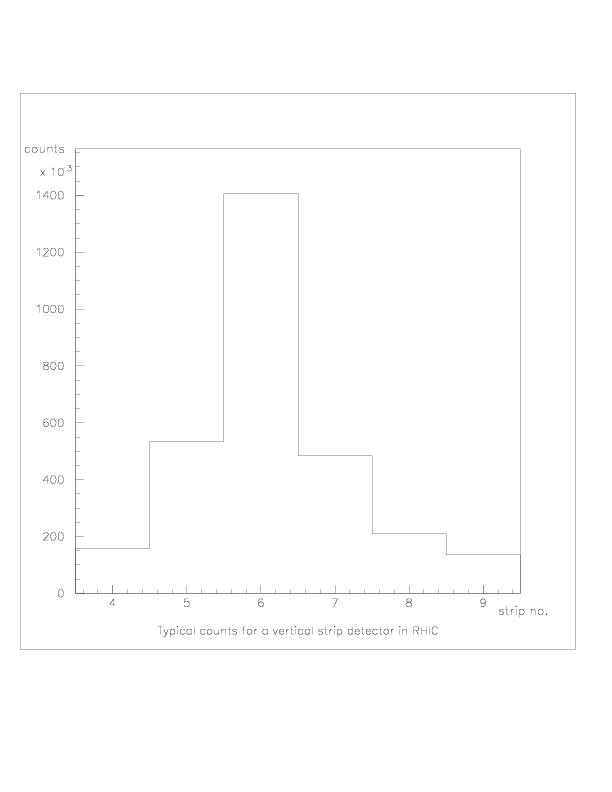Rate Estimate for AGS CNI Polarimeter
The RHIC CNI polarimeter has two detectors with vertically oriented strips and four with horizontal strips. The acceptances and rates are different for the different detector orientations. The AGS CNI polarimeter will only have two detectors with vertical strips for the FY03 run. So, we will base our AGS CNI rate estimate on the rates from only the vertical strip detectors in RHIC.
Typical rate for both vertical strip detectors in RHIC during previous run:
(6.2×106 events)/(40 s) = 1.5×105 events/s
To estimate the rate in the AGS we will correct for differences in the flux, detector acceptance, beam size and target width.
Flux:
AGS - 6 bunches, 1.2×1011 protons/bunch, seperated by 400ns
RHIC - 55 bunches, 1×1011 protons/bunch, seperated by 200ns
(1.2×1011/400 ns)/(1×1011/200 ns) = 0.6
Detector Acceptance:
The polarimeters have different detector acceptances because the detectors are placed further from the target in the AGS.
AGS - 25 cm distance from target to detector
RHIC - 15 cm distance from target to detector
(15 cm)/(25 cm) = 0.6
Beam size: beam size is proportional to square root of beta function amplitude
beta function amplitude @ AGS polarimeter: 20
beta function amplitude @ RHIC polarimeter: 30
(20/30)½ = 0.86
Target width:
AGS target width: 600 µm
RHIC target width: 5 µm
600/5 = 120
Rate estimate for AGS CNI polarimeter:
(1.5×105 events/s)(0.6)(0.6)(0.86)(120) = 5.6×106 events/s
AGS acceleration info:
41 imperfection resonances between injection and extraction (pbeam = 2.27 to 24.32 GeV/c)
ramp time (w/ Siemens): 410 ms
with 5% partial snake, spin flips sign every 10 ms
For machine tuning we would like to take measurements throughout the ramp with 2 ms bins. This will give 5 points between vertical polarization zero crossings, which should be enough to locate the polarization zero crossing point and be used as beam energy calibration.
(5.6×106 events/s)(0.002 s/2 ms) = 1.1×104 events/2 ms
We want to have 107 events in each 2 ms bin. This would require 900 ramps.
If we allow 5 sec for each ramp, the measurement time to acquire 107 events in each 2 ms time bin is 75 min.
Statistical error: ΔP = 1/(AN×N½).
We assume AN = 0.01 (consistent with
E950 measurement)

for 900 ramps, 2 ms bins: ΔP = 3%
Istantaneous strip rate:
The Si strip detectors (SSDs) in the AGS CNI polarimeter have their strips oriented vertically. With this orientation the distribution of recoil carbons will be peaked at a single strip for a given beam energy.
In RHIC a typical value for counts in the peak strip is 1.4×106
(1.4×106 events/strip)/(40 s) = 3.5×104 events/strip/s
In AGS we expect:
(3.5×104 events/strip/s)(0.6)(0.6)(0.86)(120)
= 1.3×106 events/strip/s
For 2 ms bins:
(1.3×106 events/strip/s)(0.002 s/2 ms)
= 2.6×10³ events/strip/2 ms
For each 2 ms time bin, there are 5000 (= 2 ms/400 ns) bunch passings.
(2.6×10³ events/2 ms)/(5×10³ bunches/2 ms)
= 0.52 events/strip/bunch passing
The scattering angle distribution in the AGS will not be as sharply peaked as in RHIC. The peak may be spread over 2 or possibly 3 strips reducing the rate to approximately
0.2 events/strip/bunch passing.
maintained by: Jeff Wood, wood@physics.ucla.edu
last updated: 12/13/02
